Water bugs and cockroaches are often mistaken for each other, leading to confusion about proper identification and treatment. While these insects may look similar at first glance, they have distinct differences in their biology, habitats, behaviors, and the threats they pose to your home. This comprehensive guide will help you correctly identify whether you’re dealing with water bugs or cockroaches, understand the key differences between these pests, and learn effective methods for prevention and control.
Quick Picks: Best Products for Cockroach Control

Editor’s Choice

Best Powder
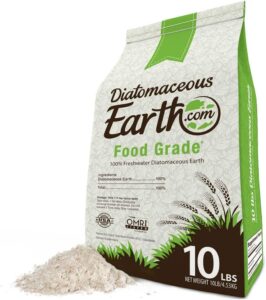
Natural Solution
Water Bug vs. Cockroach: Understanding the Key Differences
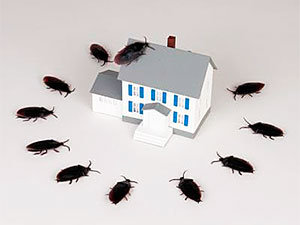 Despite their similar appearance, water bugs and cockroaches belong to completely different orders of insects. True water bugs are members of the order Hemiptera (true bugs), while cockroaches belong to the order Blattodea (which also includes termites). This taxonomic difference explains many of the distinct characteristics that set these pests apart.
Despite their similar appearance, water bugs and cockroaches belong to completely different orders of insects. True water bugs are members of the order Hemiptera (true bugs), while cockroaches belong to the order Blattodea (which also includes termites). This taxonomic difference explains many of the distinct characteristics that set these pests apart.
Unfortunately, the confusion between these insects is common because the term “water bug” is often incorrectly used to describe certain cockroach species, particularly the Oriental cockroach (Blatta orientalis). This misidentification can lead to ineffective pest control strategies and prolonged infestations.
Let’s examine the key differences between these insects in detail:
Taxonomy and Classification
| Characteristic | Water Bugs | Cockroaches |
|---|---|---|
| Scientific Order | Hemiptera (true bugs) | Blattodea |
| Common Types | Giant water bug, electric light bug, toe biter | American, German, Oriental, Florida woods cockroach |
| Number of Species | Approximately 1,500 worldwide | Over 4,500 species worldwide |
| Evolutionary History | Relatively recent evolution | Ancient insects (over 300 million years) |
Physical Appearance and Identification
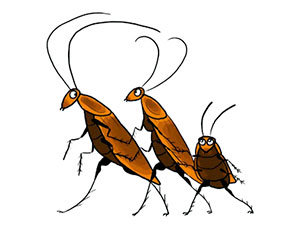 While both insects have oval-shaped bodies, there are several distinguishing features that can help you tell them apart:
While both insects have oval-shaped bodies, there are several distinguishing features that can help you tell them apart:
- Size: True water bugs are typically larger than most household cockroaches, reaching up to 4 inches in length for some species. Common household cockroaches are usually between 0.5 to 2 inches long, depending on the species.
- Color: Water bugs are generally dark brown to black with a more uniform coloration. Cockroaches vary in color from light tan to reddish-brown to nearly black, depending on the species.
- Legs: Water bugs have specialized front legs that are adapted for capturing prey (resembling pincers) and paddle-like hind legs designed for swimming. Cockroaches have more uniform legs designed for quick movement on land.
- Mouthparts: Water bugs have piercing-sucking mouthparts designed to inject digestive enzymes into their prey and then extract the liquefied tissues. Cockroaches have chewing mouthparts designed for scavenging various food sources.
- Antennae: Cockroaches have noticeably long, thin antennae (with over 150 articulated segments in some species), while water bugs have shorter and less prominent antennae.
- Wings: Adult water bugs typically have wings that form an X-shape when folded, while cockroach wings (when present) usually lie flat over the back.
Water Bug Features
Larger size (up to 4 inches), dark brown to black coloration, specialized swimming legs, piercing mouthparts, and shorter antennae.
Cockroach Features
Smaller size (0.5-2 inches), varied coloration, uniform legs, chewing mouthparts, and very long, thin antennae.
Habitat and Environment
One of the most reliable ways to distinguish between these insects is by understanding their preferred habitats:
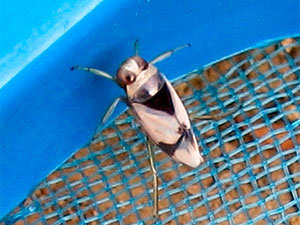 Water Bug Habitats: True to their name, water bugs are aquatic or semi-aquatic insects that spend most of their lives in or near freshwater environments. They inhabit ponds, lakes, marshes, and slow-moving streams with abundant vegetation. They’re excellent swimmers with specialized legs adapted for moving through water. When found near homes, they’re typically near standing water, outdoor pools, or water features.
Water Bug Habitats: True to their name, water bugs are aquatic or semi-aquatic insects that spend most of their lives in or near freshwater environments. They inhabit ponds, lakes, marshes, and slow-moving streams with abundant vegetation. They’re excellent swimmers with specialized legs adapted for moving through water. When found near homes, they’re typically near standing water, outdoor pools, or water features.- Cockroach Habitats: Cockroaches are terrestrial insects that prefer dark, warm, and humid environments. While they need water to survive, they cannot live in water like water bugs. Common cockroach habitats include kitchens, bathrooms, basements, and other areas with food, moisture, and shelter. They hide in cracks, crevices, and tight spaces during the day and emerge at night to forage.
If you find an insect inside your home, especially in your kitchen or bathroom, it’s much more likely to be a cockroach than a true water bug. True water bugs rarely enter homes unless accidentally carried in or attracted to bright lights during mating season.
Behavior and Diet
The behavioral differences between water bugs and cockroaches are significant and can help with identification:
| Behavior | Water Bugs | Cockroaches |
|---|---|---|
| Feeding Habits | Predatory hunters that capture and feed on small aquatic animals | Omnivorous scavengers that feed on a wide variety of organic matter |
| Social Behavior | Generally solitary except during mating season | Often live in groups or aggregations |
| Activity Pattern | Primarily nocturnal but may be active during day | Strongly nocturnal, hiding during daylight hours |
| Response to Light | May be attracted to lights, especially during mating season | Actively avoid light and scatter when exposed to it |
| Aggression Level | Can deliver painful bites if handled or threatened | Generally non-aggressive and avoid human contact |
Unlike cockroaches, true water bugs can deliver painful bites if handled or threatened. They inject digestive enzymes that can cause significant discomfort, swelling, and in some cases, allergic reactions. Always use caution when removing water bugs from pools or water features.
Diet and Feeding Habits
The dietary preferences of these insects reveal important differences:
 Water Bug Diet: Water bugs are predatory insects that hunt and kill small aquatic animals like tadpoles, small fish, and other aquatic insects. They use their powerful front legs to capture prey and their piercing mouthparts to inject digestive enzymes, liquefying their prey’s internal tissues before consuming them.
Water Bug Diet: Water bugs are predatory insects that hunt and kill small aquatic animals like tadpoles, small fish, and other aquatic insects. They use their powerful front legs to capture prey and their piercing mouthparts to inject digestive enzymes, liquefying their prey’s internal tissues before consuming them.- Cockroach Diet: Cockroaches are omnivorous scavengers with remarkably diverse diets. They can consume almost any organic matter, including food scraps, paper, glue, soap, hair, dead skin cells, and even other dead cockroaches. This dietary flexibility contributes to their success as household pests, as they can find sustenance in almost any environment.
Life Cycle and Reproduction
Understanding the reproductive cycles of these insects can help with identification and control:
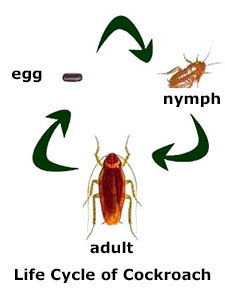 Water Bug Life Cycle: Water bugs undergo incomplete metamorphosis with three life stages: egg, nymph, and adult. Female water bugs typically lay eggs on floating vegetation or debris. The entire life cycle can take up to 600 days, depending on the species and environmental conditions.
Water Bug Life Cycle: Water bugs undergo incomplete metamorphosis with three life stages: egg, nymph, and adult. Female water bugs typically lay eggs on floating vegetation or debris. The entire life cycle can take up to 600 days, depending on the species and environmental conditions.- Cockroach Life Cycle: Cockroaches also undergo incomplete metamorphosis, progressing through egg, nymph, and adult stages. Unlike water bugs, many cockroach species produce egg cases called oothecae, which protect the developing eggs. Depending on the species, a female cockroach can produce hundreds to thousands of offspring in her lifetime, which typically spans about one year.
Health Risks and Concerns
Both water bugs and cockroaches pose different types of health risks:
- Water Bug Health Risks: The primary health concern with true water bugs is their painful bite, which can cause discomfort, swelling, and potential allergic reactions in sensitive individuals. However, they are not known to transmit diseases to humans and rarely infest homes.
- Cockroach Health Risks: Cockroaches pose more significant health risks as they can:
- Carry and spread pathogens that cause food poisoning, diarrhea, and other illnesses
- Trigger allergic reactions and asthma attacks, especially in children
- Contaminate food and surfaces with bacteria from sewers and garbage
- Leave behind allergen-containing feces and shed skins that can affect indoor air quality
Cockroach allergens are a significant trigger for asthma, particularly in urban environments. Their saliva, feces, and shed skins contain proteins that can cause allergic reactions and exacerbate respiratory conditions in sensitive individuals.
How to Determine if You Have Water Bugs or Cockroaches
If you’ve spotted an insect and are unsure whether it’s a water bug or a cockroach, consider these simple assessment strategies:
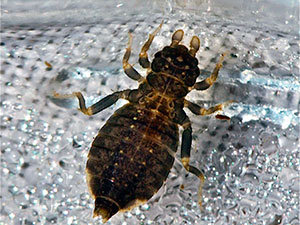 Location of Discovery
Location of Discovery
Where did you find the insect? True water bugs are almost exclusively found in or near water sources like ponds, pools, or other standing water. If you found the insect inside your home, especially in the kitchen or bathroom, it’s most likely a cockroach.- Physical Characteristics
Examine the insect carefully (from a safe distance). Is it larger than 2 inches with specialized front legs that look like pincers? Does it have relatively short antennae? These traits suggest a water bug. Long, thin antennae and uniform legs are indicative of a cockroach. - Behavior When Disturbed
How does the insect react when disturbed? Cockroaches typically scatter quickly and seek dark hiding places when exposed to light. Water bugs may move more deliberately and might even display aggressive behavior if they feel threatened. - Coloration and Body Shape
True water bugs are typically dark brown to black with a more uniform coloration. Most cockroach species have variations in color, from light tan to reddish-brown to dark brown. Oriental cockroaches, often misidentified as water bugs, are very dark brown to black with a shiny appearance.
If you’re still unsure after assessing these factors, consider taking a clear photo of the insect (from a safe distance) and consulting with a professional pest control service or entomologist for accurate identification.
Effective Control and Prevention Methods
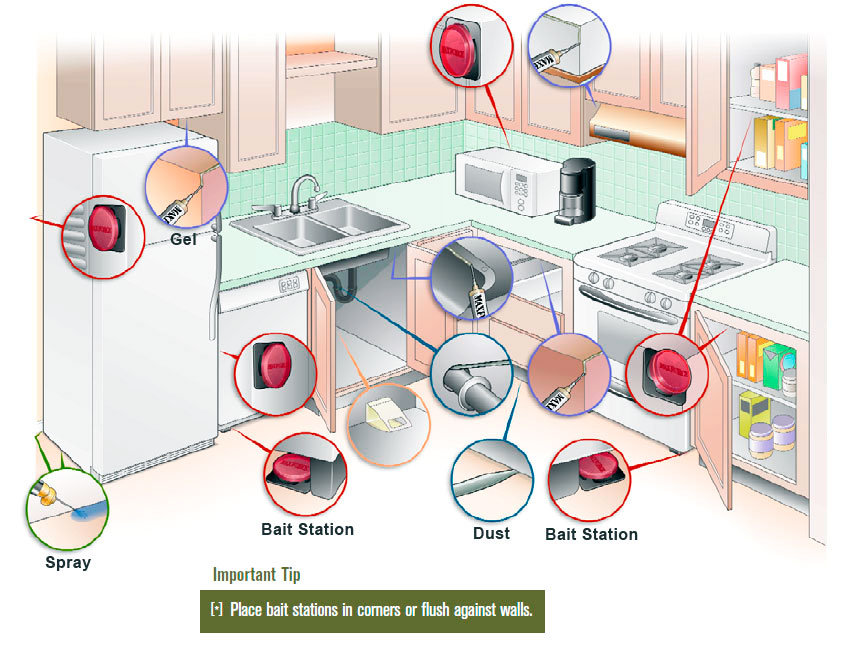
Once you’ve determined whether you’re dealing with water bugs or cockroaches, you can implement targeted control strategies:
Controlling and Preventing Water Bugs
True water bugs rarely infest homes and are typically only a nuisance when they appear in swimming pools or water features. To manage them:
- Reduce Standing Water: Eliminate or regularly maintain standing water sources around your property, including birdbaths, unused pools, clogged gutters, and areas with poor drainage.
- Maintain Pool Chemistry: Properly chlorinate swimming pools and maintain filtration systems to make them less attractive to water bugs.
- Reduce Outdoor Lighting: During mating seasons, minimize outdoor lighting, which can attract flying water bugs. Consider using yellow “bug lights” that are less attractive to insects.
- Physical Removal: Use a pool net to remove water bugs from swimming pools. Remember to use caution, as water bugs can bite if handled.
- Manage Aquatic Vegetation: Control excessive aquatic vegetation in ponds or water features, as these provide breeding sites for water bugs.
Controlling and Preventing Cockroaches
Cockroach control requires a comprehensive approach focused on sanitation, exclusion, and targeted treatment:
Step 1. Sanitation and Prevention
 The foundation of any successful cockroach control program is proper sanitation:
The foundation of any successful cockroach control program is proper sanitation:
- Eliminate Food Sources: Store food in airtight containers, clean up spills immediately, and don’t leave dirty dishes overnight. Regularly clean under and behind appliances, especially refrigerators and stoves.
- Reduce Moisture: Fix leaky pipes and faucets, use dehumidifiers in damp areas, and ensure proper ventilation in bathrooms and kitchens.
- Remove Clutter: Reduce stacks of newspapers, magazines, cardboard boxes, and other items that provide hiding places for cockroaches.
- Regular Cleaning: Vacuum frequently, paying special attention to cracks and crevices where crumbs and food particles might accumulate.
- Proper Waste Management: Use sealed trash containers and empty them regularly, especially in the kitchen.
Never leave dirty dishes in the kitchen overnight or pet food in bowls after feeding time. These practices provide easy food sources for cockroaches and can attract them to your home.
Step 2. Exclusion Techniques
Prevent cockroaches from entering your home by implementing these exclusion methods:
- Seal Entry Points: Inspect your home for cracks, gaps, and openings in walls, foundations, and around pipes or utility lines. Seal these potential entry points with caulk or other appropriate materials.
- Install Door Sweeps: Add door sweeps to exterior doors to eliminate gaps that cockroaches can use to enter your home.
- Screen Vents: Ensure that all vents and other openings to the outside are properly screened.
- Check Packages: Inspect grocery bags, boxes, and other packages before bringing them into your home, as they may contain hitchhiking cockroaches or their egg cases.
Step 3. Effective Treatment Products
When preventive measures aren’t enough, consider these effective treatment options:
Advion Cockroach Gel Bait
Editor's ChoiceHow Does It Work
How to Use
- Apply small dots of gel in areas where cockroaches travel and hide, such as under appliances, along baseboards, in cabinet hinges, and around plumbing fixtures
- Place bait dots in multiple locations throughout the infested area, using more in heavily infested areas
- Reapply as needed when bait is consumed or every 2-3 months
- Avoid applying where cleaning products might wash away the bait
- Highly effective against even resistant cockroach species
- Secondary kill effect helps eliminate the entire colony
- No offensive odor
- Precise application means bait can be placed exactly where needed
- Does not repel cockroaches, encouraging them to consume the bait
- May require multiple applications for severe infestations
- Slightly more expensive than some other options
- Must be kept away from children and pets
- Effectiveness decreases if exposed to water or cleaning chemicals
Harris Boric Acid Powder
Best PowderHow Does It Work
How to Use
- Apply a very thin, barely visible layer of powder in areas where cockroaches travel and hide
- Focus on areas under appliances, behind toilets, under sinks, and along baseboards
- Avoid applying thick layers, as cockroaches will simply walk around them
- Reapply after cleaning or if the powder becomes wet
- Keep away from areas where food is prepared or where children and pets have access
- Long-lasting effectiveness when kept dry
- Works slowly enough to allow cockroaches to return to nesting areas, potentially affecting others
- Non-staining and odorless
- More economical than many other treatment options
- Lower toxicity compared to many chemical insecticides
- Must be applied correctly (very thin layer) to be effective
- Not effective if it becomes wet
- May take 1-2 weeks to see significant results
- Can be visible on dark surfaces
- Should be kept away from children and pets
Food-Grade Diatomaceous Earth
Natural SolutionHow Does It Work
How to Use
- Apply a thin dusting to pantry shelves, corners, and crevices
- Use a small brush or powder applicator for precise application
- Focus on areas where larvae might travel
- Reapply after cleaning or when dust is disturbed
- Keep food items in sealed containers separate from the powder
- 100% natural and non-toxic
- Effective against multiple pantry pests
- Long-lasting until physically removed
- No chemical residues or odors
- Safe for use around food storage areas
- Can be messy if overapplied
- Respiratory irritant if airborne (apply carefully)
- Must keep dry to remain effective
- Takes time to work (not an instant kill)
Step 4. Professional Pest Control
For serious infestations or persistent problems, professional pest control services offer several advantages:
- Accurate Identification: Professionals can correctly identify the specific species you’re dealing with and tailor treatment accordingly.
- Comprehensive Approach: Professional services typically employ an integrated pest management (IPM) approach that combines multiple control strategies.
- Access to Professional Products: Pest control professionals have access to commercial-grade products and equipment that may not be available to consumers.
- Targeted Application: Professionals know exactly where and how to apply treatments for maximum effectiveness with minimal exposure to household members.
- Follow-up Services: Most professional treatments include monitoring and follow-up visits to ensure complete elimination of the infestation.
Once you have implemented sanitation measures, sealed entry points, and removed food and water sources, professional extermination can effectively eliminate any remaining cockroaches. Most reputable companies offer guarantees for their services.
Frequently Asked Questions
Can water bugs infest my home like cockroaches?
True water bugs rarely infest homes, unlike cockroaches. Water bugs are aquatic insects that prefer to live in freshwater environments like ponds, lakes, and slow-moving streams. They might occasionally enter homes if attracted to lights during mating season or accidentally carried in, but they don’t establish breeding populations indoors since they require water to complete their life cycle.
If you’re finding numerous similar-looking insects inside your home, especially in kitchens or bathrooms, you’re most likely dealing with cockroaches, not true water bugs.
Are water bugs and cockroaches equally dangerous to human health?
No, cockroaches generally pose a greater health risk than true water bugs. Cockroaches can spread various pathogens that cause food poisoning, diarrhea, and other illnesses. They also produce allergens that can trigger asthma attacks and allergic reactions, especially in children.
Water bugs don’t typically spread diseases to humans, but they can deliver painful bites if handled or threatened. Their bites can cause discomfort, swelling, and potential allergic reactions in sensitive individuals, but they’re not known as disease vectors.
Why is my home suddenly infested with cockroaches?
Sudden cockroach infestations can occur for several reasons:
- Recent changes in the environment, such as construction or demolition nearby, forcing cockroaches to seek new habitats
- Introduction through groceries, packages, or used furniture
- Weather changes driving cockroaches indoors, especially during extreme heat, cold, or heavy rainfall
- New food or water sources becoming available in your home
- Neighboring properties being treated for cockroaches, causing them to migrate to untreated areas
To address an infestation, focus on sanitation (eliminating food and water sources), sealing entry points, and using appropriate baits or professional pest control services.
Do water bugs bite humans?
Yes, true water bugs can bite humans, unlike most cockroaches. Water bugs have piercing-sucking mouthparts designed for hunting prey, which they can use defensively if they feel threatened or are mishandled. Their bites can be quite painful as they inject digestive enzymes that help liquefy their prey’s tissues.
Cockroaches, on the other hand, rarely bite humans. They have chewing mouthparts designed for scavenging food rather than biting. While cockroach bites can occur in severe infestations or when food is extremely scarce, they’re uncommon and generally less painful than water bug bites.
What’s the best way to keep cockroaches out of my home?
The most effective approach to keeping cockroaches out of your home is a combination of prevention strategies: Regularly sealing entry points, such as cracks and crevices, can greatly reduce the likelihood of an infestation. Additionally, understanding white cockroach characteristics and habits can provide valuable insight into their behavior, allowing you to identify potential risks. Maintaining cleanliness and minimizing food sources will further enhance your efforts in keeping them at bay.
- Maintain cleanliness: Regularly clean kitchen surfaces, floors, and appliances to eliminate food residues that attract cockroaches.
- Eliminate moisture: Fix leaky pipes, use dehumidifiers in damp areas, and ensure proper ventilation in bathrooms and kitchens.
- Seal entry points: Inspect your home for cracks, gaps around pipes, and openings in walls, and seal them with caulk or appropriate materials.
- Proper food storage: Store food in airtight containers and avoid leaving pet food out overnight.
- Regular garbage disposal: Use sealed trash containers and empty them frequently.
- Preventive treatments: Apply appropriate baits or insect growth regulators before problems occur, especially in high-risk areas.
Why are cockroaches sometimes called water bugs?
Cockroaches, particularly Oriental cockroaches (Blatta orientalis), are often mistakenly called “water bugs” for several reasons:
- Oriental cockroaches prefer damp environments like basements, sewers, and areas near plumbing, giving the impression they’re associated with water.
- Their dark, shiny appearance somewhat resembles true water bugs.
- The term “water bug” might be used euphemistically, as people may find it less distressing to report having “water bugs” rather than “cockroaches” in their homes.
- Regional language differences and vernacular naming have perpetuated this misidentification over time.
Despite this common terminology, Oriental cockroaches are not true water bugs and belong to a completely different insect order.
Conclusion: Taking Effective Action
Understanding the differences between water bugs and cockroaches is crucial for implementing effective pest management strategies. While both insects may look similar at first glance, they have distinct characteristics, behaviors, and control requirements.
Key Takeaways
- True water bugs are aquatic predators that rarely infest homes, while cockroaches are terrestrial scavengers commonly found in human habitations.
- Water bugs have specialized legs for swimming, shorter antennae, and can deliver painful bites; cockroaches have uniform legs, long antennae, and rarely bite humans.
- Cockroaches pose greater health risks through disease transmission and allergen production than water bugs.
- Effective cockroach control requires a comprehensive approach focusing on sanitation, exclusion, and targeted treatments.
- For persistent or severe infestations, professional pest control services offer specialized expertise and access to commercial-grade products.
Whether you’re dealing with occasional water bugs around your pool or a cockroach infestation in your home, prompt identification and appropriate action are essential. By understanding the unique characteristics and behaviors of these insects, you can implement effective control strategies tailored to the specific pest you’re facing, protecting your home and family’s health in the process.
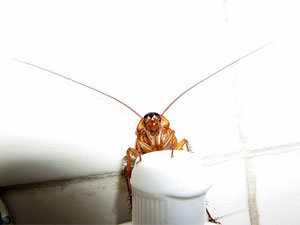
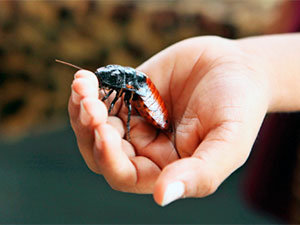
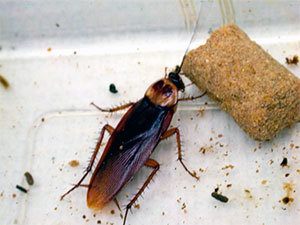

The appearance and behavior of Oriental and American cockroaches are almost similar to water bugs. Therefore, you will not be able to find any significant difference in between these two types in terms of appearance.
I’ve lived in my house for 15 years and have never seen a cockroach here until a week ago. It was in our garage. I was able to kill it so I thought “no big deal”. Tonight there was one in our basement. I was able to kill this one too. So I guess I have 2 questions/concerns. #1 Can cockroaches travel on a person’s clothing? I ask this because I have a friend who lives in a very filthy camper and his last 2 visits here match the timeline and areas I found the roaches. #2 Should I start exterminating right away? Any help would be greatly appreciated, I am so creeped out by roaches. I’ll freak out if this turns into an infestation!
We have a pool in the backyard, and we have six oak trees that provide endless piles of leaves from late summer through the winter. We have always had the dreaded water bugs. Usually these massive monsters can be found dead or dying belly up on the floor. Occasionally these armored aviators can be heard before being seen, I kid you not, flying across the room. Today we are going to Home Depot to buy bags of D.E. to spread around the foundation of the house, and we’ll pick up extra weather stripping to secure the doors. Thanks for the tip!
All I can say is brother big roach was here before us and will be after us. I just wish he go hang out somewhere else instead of my apt. I really don’t want his kind of company. I read all the responses. Thanks for the help. I appreciate it. Least I know it isn’t me alone.
The difference has no merit to me they’re both discussing creepy skin crawling bugs or animals if you will, and the one I found in my tub yesterday is probably by now cooking hotdogs over an open fire he built. Gee I hope it’s a waterbug cause if it’s a roach it might get offended.
Do outside pets attract water bugs?
I think this article was written by a small child. Seen better 3rd grade school projects than this.
The true key to dealing with these creatures is understanding enough about them and what the world is like for them. If you have a hard time visualizing it, just remember the movie ‘honey i shrunk the kids’ and how the smallest crumb of some junk food can go a very very long way for these guys. Learn about the type of foods and enviroments they like and need – and use this information to make coming anywhere near your home like crossing the sahara desert. No food, no water, no discernable scents of food or anything desirable- i cover it up by wiping with lemon scented ammonia wipes. Cleaning the floors with pine or ammonia, all windows and mirrors with windex (which has ammonia) – the spray bottle of windex is a great way to do target practice. Alternatively you can fill a sprayer bottle with 50/50 vinegar/water or water super saturated with boric acid – now you have a way to apply it deep into crevices and drains water evaps and leaves behind the acid – be sure the sprayer can handle the powder without clogging, dry oppressive, stinky and cold, from thier perspective. They also seem to stay away from the scent of vinegar as well as pine – all scents i can tolerate. Those of you wearing contact lenses need to be careful because tiny bits of vapors like from ammonia or bleach (which should NEVER be used near eachother by the way)can become trapped underneath the lens and cause serious problems.
With certain bugs like the new york waterbug which seems to be one hell of a survivor, those alien looking bodies are actually coated with a substance that is very simililar to your own ear wax. This is probably why certian ones like human ears, it’s like going to car wash. Again, thinking from thier perspective helps you figure out how to deal with them.
This waxy coating is very important for thier survival, but it needs to remain flexible for them to move – so any enviroment with an ambient temp below say about 60 degrees farenheight and a relative humidity below lets say 50 percent is very uncomfortable for them. I happen to love the cold and being like a OCD CSI about not leaving food traces anywhere helps a lot to keep them away, even when you live with slobs.
They’ll hang out with the slobs who smell the best and leave you alone. It’s a symbiotic relationship. Just make sure your kitchen and bathrooms get regular perimeter sprays of home defense or something and cleanings with ammonia OR bleach, never both
An important thing to note is that they use those anntenna to communicate and to sniff out food. They communicate at least partially through some type of phermones (which you can smell ) and some form of sonic pitch noises just outside the range of human hearing, but i could be confusing them with rats here. This is also partly why they prefer air that is above 65F, warm, stale, non moving air and humid enviroments. What this tells us is that for those who prefer to prevent, scents they stay sway from, a chilled room and some moving air are your best freinds here. So are tupperwear containers and ziploc bags.
Those of you with baseboard peoblems should replace the board with cederwood – it repels them because they hate the smell – i suspect that since these bugs pretty much see with thier noses, these scents are like a bright blinding light
Mint is a good one too, rats hate it since it overwhelms those super sensitive noses.
Ive heard lavendar repels roaches but may attract dragon flies, this is similar to the bait problem,you dont want to attract them, you want them to pack up and leave for greener pastures.
Anyway i hope this helps someone.
become the predator rather than the prey for these things and allow nature to eesp.
Okay I have never ever ever had these things in my life I had to move into the place I am two years ago due to an extreme emergency we had a fire so I’m in a trailer park I haven’t had them here either until about 4 weeks ago I have only seen 4 of them but the girl that lives next to me her place is so infested that they are pouring out of her place they are all over her counters and everything even during the day I’m not infested but I need to stop this but I have animals so it has to be safe for them as I have no place for them to go I don’t know what to do can anyone help me with out being negative about this please
Occasionally in the morning I am finding what I think are roaches on the bottom of my bathtub! Very isolated incidents and only one at a time. We have recently had some drain issues with lots of plunging going on. Could these insects be in my drains and if so what can I use to get rid of them?
Nothing. If they are in your pipes and drains they are there to stay I am afraid…That’s until they procreate more and more and then they will start to invade your home. It’s probably too late already. My advice to to become one with the roaches and embrace them, become their friend.
I live in Oklahoma. I bought a house in June 2005. It had new carpet and in the large bedroom masking tape had been left on the carpet all around the edges, I suppose for painting. When I pulled the tape off, it was completely covered with these 3/8″ bugs (cockroach or water bug). I have not been able to get rid of these bugs. They would come in Spring and disappear in fall. I also had a berry tree at my back door. I went out one night and the ground was covered with black bugs. I freaked out! We had the tree cut down, but the bugs are still here. I have done best with the baits, but where the baits are, so are the bugs. I just sprayed my bedroom with Home Defense. Bugs were back next night. One bit me on my bed! We never had bugs growing up. Or rather, I remember a few water bugs, Mom called them. Never an infestation. Eleven years now. I am going to try boric acid. Sure hope it works and my dog doesn’t get into it. The spray bothers my allergies. I hope to get some control before winter. Thanks for all comments and suggestions. Think I will also get more bait and glue things. Over the last 3-4 years I also have earwigs. Yuk! Hard to kill. Blessings to all of you.
Water sources and they love the plumbing electric wires they eat off of their own nuclear bombs won’t eliminate the egg sacs constant cleaning literally one apartment has it the whole building has them schools have them everywhere every type. They eat our dead skin get together with all joining neighbors otherwise they just keep going back and forth when they poison eventually they’ll end up right back. Common emergency room visit roaches going into ears getting stuck. Your car will have them too if bringing A backand forth especially if you park by a dumpster or if u set a bag dow outside bugs crawl in u cab have the cleanest house and still have the issue I do not care about spell check I have a life. If you have a storage unit guess what roaches. Grow up get ur home in order!you cannot let it get out of hand and I did a little bit of everything the whole building got them when an elderly disabled couple moved they were too sick to help them selves garbage food everywhere when they moved
If it was just the spelling then maybe it would be okay, but with the punctuation issues as well as the run on sentences it’s very hard to understand what we are reading. Just because you have a life ( not much of one) doesn’t mean that you can’t know how to spell, speak or write proper English. It just makes you sound ignorant
Just moved into a home…. 3 days later noticed. Lil bugs thru out home. Window ledges, kids mattress. …dont know what they are small. Resembles more a beetle body frame…. Arghhh. So upset. Never. Had. Issues in my entire life with bugs till now
They are most likely German roaches.
Sounds like bed bugs
I moved from the east coast to the west. Didn’t grow up or around roaches. The apartment was empty but not scrubbed. We saw roaches here and there. They bombed and sprayed. Basically soaking the walls with outdoor bug spray. Nothing worked. I slept in the car a few nights while my bf slept in the apartment. They were Always in the kitchen, on the walls and carpet. For the first year or 2 we didn’t get any furniture. Just a bed and table. After the first year I had cleaned, scrubbed, caulked, sprinkled and sprayed so much I now have a cyst on my wrist. It’s crazy. You would think if a place has a bug issue this bad they would bomb sections at a time. Not place by place, only for the roaches to run back and forth. My mother in law saw plugs on QVC for bugs. We’ve seen 5 roaches and 1 water bug in the 2 years since. Which probably made there way in because some one else’s apartment was sprayed or bombed. They are made by Bell Howell. A pack of 3-5 is about $30 on Amazon.
I believe that people who are confused by this article are just not reading carefully enough; missing key words and phrases like “known as”, “generally” ect…these bug species are in the same family so they are very genetically similar. So there is a lot of crossover here.
We live in Sun City, Arizona and when it gets really hot here we have some kind of huge bug that I have been told is a Water Cockroach by neighbors. We don’t see them running. All we see are the belly up version laying on the floor. This week we found one in the kitchen; one in a bathroom and one on the computer room floor…all belly up and two of them weren’t dead yet. We have been told to cover our drains and toilets if we leave for any length of time???? Sinks, toilets, shower/tub. Does that make sense? Our House is clean and food/dirty dishes not left out. They are definitely creepy!
Hi my name is Tina and I dont know if they are water bugs or not, I know when it rains these things come out more, I walk outside and these things are scurring along the porch but the same ones that are outside are coming inside, All this week I have been going to the kitchen and when I turn the light on they are everywhere and running they are always by the window and sink and they are very huge with wings I guess. They are very creepy and I read this article and its says they are toe biters so that doesnt help matters any either, I am so terrified of these things especially when thier are little ones sleeping and I dont want them near the babies what do I do, I have little ones and animals, these lazy freakin cats are helping kill them, ugh!!!
I actually was fixing to go to sleep one night and a huge water bug flew out and landed on my face. Needless to say I never went to sleep
I just purchased a foreclosured HUD home. I only own 3 lamps a fridge that doesn’t work and installed all new stove and microwave. That is all i have in my home. I stay at mom house till I’m ready to move however I’m noticing every day i go back to my home a new dead water bug. I never see them when I’m there and I’m terrified of anything that looks like a roach always have been. I spray all the time but i want them gone! ! I have a lot of pine trees in the back and wondering if that’s part of my problem. Trust i won’t be spending the night in my own home until this is over! Otherwise I’ll end up in the ER from panic attack. I notice them outside hanging around the porch . My mom opened the door to leave and 1 ran right on in. She killed it thank goodness but i saw another one by the door. It’s giving me anxiety that they may be there during the day I’m there and i just can’t see them. I have no air on while I’m not there either. All leaks have been repaired as well so i have no food source Cuz i don’t even have food over there since I’m still living with my mom . Please help. #scaredfirsttimehomebuyer
Once you think they are all gone and haven’t seen them for a while, you’ll move in, and then notice them again crawling all over the place. They love the dark
Once there they will never leave.
I have a clean home; No food left out; No dirty dishes; No cardboard boxes. Yet, large bugs are in my kitchen, bathroom, bedroom. They used to come out at night. Now, during the day I am afraid for anyone to visit. They run under the washing machine and refrigerator. My house has a bad smell like dying bugs. Help! I don’t know what to do. Everytime I see one it’s larger than the one before. Just last night I saw it fly from the wall, walk along the baseboard and disappear.
That’s totally crazy it’s the same here in my house and they fly !!! Omg. I can’t with this and don’t know what to do. Everything is always clean.
I am very lucky have none but I can tell ya look in your potatoes and onions and stuff like that cause they r shipped and get in the bags and stuff I know this cause my grandmother came home and one came cawrling out she never had one till that day she screamed it got away she finally had ta put bait out for them so I get the pototoes and onions that u puck your self not the bag one’s
Okay I’ve read everything and I still don’t fully know for sure it’s these are Water Bugs or Oriental Cockroaches. They have taking over our house inside and out. You need to know that I live in Oklahoma. We did not have a good winter. And it has flooded a lot more. (Flooded!!).these things are huge and either dark dark brown or Black. I have never seen anything like these before. These are approx 1″ and I think the female is over an inch. Does anyone have more than 1 picture for water bugs? Or where can I find them? I’m used to seeing the textbook cockroach here in Tornadoville! I’m at my wits end. Thank you everyone for all the information! Very helpful 🙂
Hi Tiffany, I’m in Okla. City. I’ve been in my house since 2005 and water bugs and 3/8″ cockroaches (?) were in my yard and house when I came. Can’t get rid of them. Hoping boric acid will work. Baits have done best for me. Exterminator didn’t get rid of them. Trying boric acid today. Blessings to you, Patty
Diatomaceous Earth works wonders. Shreds the crap out of the exo of the insect, and they dry out in a few hours. I love the stuff. Hell, I actually took 2 tablespoons of the food grade stuff with my coffee every day for detox for a bit. Be careful to get ONLY food grade. Anything else could get airborne and do the same thing to your lungs, that the food grade does to an insect’s exoskeleton.
Bleach all cracks and crevises ,,it worked for me
I live in apartment which I am the last one on a row for over 20 years. For the last 3 years ago I been dealing with differ types of roaches. When the owner spray they get worst the 2 types of Raid, baits, gel, glue and hot shot I used is not helping. What can i do next.
Omg I also never had one! The ppl that moved upstairs last year. Ask me today. If I ever seen a roch! I said no..Omg she said there crawling on her ceiling. I’m on first floor. I said please call the landlord.. asap. We’ll she didn’t. As soon as I heard that. Everything in my kitchen and bathroom got thrown out. Food everything. And I called the landlord. He said they never told him. I’m so upset! Now I am in a panic. I see a light brown bug.above my sink. Kill it.called landlord back. Crying. WAiting for the bug man too get here! What I’m saying if they Don’t do there parts upstairs. . .. they won’t go away. ..only seen one but now I’m full with anxiety. .! Will they go away after they have been treated? ? And, stay away. .or do I have to leave Everything I own..and move .
Advion Bait. See Amazon for details and reviews. It works. I feel for you, so I figured I would let you know about this product.
I’ve had my house 15 years and never a bug last summer at night they would run when the light went on in the kitchen and bath room. They run on the walls , not a lot but one is bad enough. There reddish brown with strips.
We bought our house new 16 yrs ago and haven’t had a roach problem until a few weeks ago. Now I’ve killed 3 in the kitchen and 1 each in the master BR and bath. 2 were already belly-up so maybe encountered the Home Defense I’ve applied for years around the exterior foundation or boric acid i put down in the master bath to control ants. Not sure how the roaches are getting inside but I am going to put stainless steel wool in the weep holes around the foundation. Inside I’ll dust boric acid behind the refrigerator and into the pipe penetrations, etc.
Our problem is solved. Turned out the water in the seldom used powder room toilet evaporated and allowed the roaches/water bugs access. I lifted the lid and saw a bunch of them in the dry bowl–really disgusting. Needless to say, it got a thorough cleaning and now gets a regular flush. Haven’t seen a single bug since.
So we just moved into our apartment not that long ago, and my fiance was.in the restroom and felt something wet fall from the ceiling we call the landlord to come and see what the issue was and she takes a look in our bathroom and says well u need to clean urair vent fan so after she leaves I do just that and OMG I swear it’s been years since she had cleaned that fan there was dust all over even wrapped around the wire, well to get to the point well cleaning up there a huge long dark bug fell down into the sink it was dead thank god but eww could it be a roach or a water bug no issues otherwise I do know she told us she bought the property a few years back so I wonder if that wasn’t just a previous left behind pest
I grew up in an apartment filled with waterbugs. Probably for about 16-17 years. It was just a way of life for us. When we were finally able to leave I was able to sleep like a normal person. That was amazing. People that live with bugs really lose a lot of their lives just trying to rid their lives of getting these insects out of our lives. I’ll never forget my teenage brother screaming in the middle of the night when a cockroach climbing in his bed freaked him out. I know any child that grows up like this has issues.
Hi, so, I have slight OCD, I clean my house religiously, I don’t even leave my house for the day or to run errands unless my house is spotless. With that said, I noticed two cockroaches or water bugs in my kitchen, near the second bathroom when going to the bathroom at night. One was smaller than the other, so I’m guessing it was the offspring. We have never had an insect problem at all while we have lived here and my house is always clean, I leave no dirty dishes out, the counters get wiped and I follow up with sweeping around the areas around the counter in case any crumbs drop. We are going to get an exterminator, but my question is, how and why would bugs enter a house with limited food sources? We have no leaky pipes as well. I’m just confused. And grossed out.
Tiffany same here .in my bathroom today it crawled from linen closet.kids put wet wash clothes in the floor next to hamper.I am praying its a water bug and was aloner.you can eat off my bathroom floor .no idea unless a kid brought a guest with them in their bag,or I have tampon boxes,tissues in closet it may have hitched a ride here from Walmart
i never had a roach problem neither. I did hear that if you live in a row home and one of your neighbors spray for bugs you can get their leftovers. And you had mentioned you have OCD, i used to be a housekeeper so I now how you are. Although your probably a better cleaner than me, lol.
Sorry for bein lame, but as far as the Water Bugs go, isn’t there a way to make them go away WITHOUT the killing?
I use flat glue boards. I just saw a flying large roach first time indoors. Omg. I can’t!!!
Have you tried Diatomaceous Earth Crawling Bug Killer? It’s as good as Boric Acid and may be a lot cheaper. You can get a 4 lb bag of the stuff, I think I bought it at Home Depot. I poured some in a clean sock and gently hit or touch all surfaces with the closed sock. inside and out of the kitchen, all walls, etc. Use a plastic bottle where you can squeeze small amounts into small crevices, behind the stove, refrig, etc. Read instructions carefully regarding children and pets. You may want to put a nose mask on so you don’t breathe it. Diatomaceous Earth and Boric Acid will last about a year on surfaces. We never had bugs after using these powders. Very economical, also.
I forgot, you really don’t need to use much of this Diatomaceous Earth Powder.
Bug Sprays are so expensive and don’t last but 2-3 months
Your comment wàs verry interesting and sound like its worth trying. However is it used for water bugs or cockroaches? I can’t figure out which kind I have. At first no doubt there were water bugs. Then we higherd an exterminator and subsequently I now have three kinds of bugs… The original wb and a small browñ kind of Roach however I didn’t see any wings, and last but not least this black bug that is oblong yet sort of diamond shape. With six jointed rather long for its size legs. I’m beside myself.
Diatomaceous Earth is a fine powder that works on most bugs. It is considered a mechanical insecticide, as it deteriorates their exoskeleton, leading to dehydration over a period of several days after they contact it. Make sure you get the food-grade version that has not been heat treated.
Amy, I hate to tell you, but it sounds like oriental cockroaches. I just bought a house, then seen a few in the house, here and there, then I looked around 4am outside on a day after it rained, and they were all over the lawn.
I would suggest searching images to id them. keep in mind the males and females are a little different in appearance. The males are dark brown (even reddish) with wings that cover all but their butt. The females are usually a little bigger, almost black, and they have tiny wings that you won’t even see unless you look really close.
If inside, I would suggest the use of a gel bait, keeping in mind that application sites will make the difference in effectiveness. (you want it close to their entrances) Also boric acid baits are effective but theres no “secondary kill” like with the baits. (with the baits, the poisoned roach returns to the nest and poisons others)
Most importantly seal any exterior cracks and crevices. Carefully inspect the exterior of your home. personally I dont believe in sealing interior walls, because that just keeps them inside your walls.
If outside, first off eliminate any harbors they may have. If you have tall weeds, mulch, compost piles, these will attract them. I would suggest keeping any grass next to the house extremely short. For further control you can get a granular form of “fipronil” (probably the most effective neuro-toxin against them) this stuff has no KNOWN toxicity to most mammals, however it will kill most bugs. If you go this route please, please use as directed. You will not see instant results either way, but in a few weeks you should. Please if you use this, understand that it really is a nasty, synthetic neurotoxin and should not be used loosely where it will wash away. it is bad for birds (they eat the bugs) if it goes to a wash, or pond it is extremely toxic to fish.
Hope this helps, best of luck. These species can be beat. (nothing like the German ones) If you caught them before they infested your house, consider yourself lucky. Get a jump on them! this is the time of year eggs are hatching. so pretty soon, for awhile you wont see as many adults. Next spring, you will see more.
Boric Acid works better than the baits. There actually is a secondary kill with Boric Acid. Roaches are cannibalistic and when they ingest the Boric Acid, they go back to the nest to and die. When the other roaches eat it, they are also poisoned. You just have to watch our for small pets and children – make sure you keep the Boric Acid away from anywhere they can reach.
Growing up, we lived in a triplex & the houses on both sides of us were infested with roaches & not 1 roach in our house. my mom used Boric Acid along all the baseboards, in crevices and in cabinets where no food would be stored – but especially around the baseboards of the bathrooms – even outside, but you have to be careful of other small animals if you do that.
i have these cockroach looking bugs that are outside only at nighttime. i dont see them during the day, and once in a while i see 1 inside my house. they are huge, and im unsure if they are cockroaches or not!
Please let me know what you have tried because I just recently have the same exact problem and i do not know what to do and i really do not want to put out the expense of an exterminator but i do not know what else to do because they are driving me crazy!!!
I have the same roaches. The only come out at night, when I spray for them with Home Defense I find them upside down on the patio legs kicking. They must be hiding in my surface drain that surrounds the pool patio for run-off. I Spray once a week till I don’t see them on their backs anymore, does the trick for me. Oh, I also have German and Oriental Roaches too. They are the light brown ones that have wings, so says my research. Good luck !!
Cockroaches are small, water bugs are big, and come out at night, if u water a lot they love that, I use a granule around the perimeter of the house and that controls them a lot!
What is granule an where do you get it at? I hate these pesky things an I’ve heard they bite other than on this site ….. Ughhhh yuck plz help thx
What granuals do you use?
Cockroaches are NOT small in Washington, D.C. where I was for a few months in college…the biggest one I saw was 2 1/2-3 inches…why I left!!!
i have done alot of research on roaches and it sounds like you seeing cockroaches. Are they brown/light Brown ? Do they look like they have wings ? If yes then these are the American Roach they are huge like 2 inches long .
Those are a type of cockroach that live outside. You will primarily see them in the summer when it’s warm. And yes they are huge.
I live in Virginia and once in awhile I’ll see these two inch cockroach looking things scurrying on the floor but once the light turns on they go into a crack in between the counters and the stove and then I won’t see one for ever. I heard it’s because I live on a slab that these bugs here in this area are common.
I live in VA as well and just started having the same problem. What do you do about your situation? They are starting to irritate me. I hate turning on the light to see one crawling around somewhere
My house is also on a slab and so far this summer I’ve killed four !!!! I thought it was an awfully big cockroach ….. As I don’t see any small ones , and they don’t tend to be shy I see and kill them during the day. ….. I don’t have any other bugs and my house is clean ……. I will look for a water source …. Thanks All for the info
The article was very good in differentiating between the household cockroach and the larger variety of dark brown water bug. It was a little confusing in one or two places.
Your information is very confusing. First you say cockroaches and the big black water bugs are different. Then you say use roach bait for both of them. I’ve tried the exterminator and their stuff doesn’t work. I need an alternative. Boric acid has been suggested to me but all my research says it useful for roaches and palmetto bugs but nor specifically for the big black water bug. Is there anything specific that is useful?
Look up unl oriental cockroaches the images are among the best for identification. if that is what you are dealing with the information on there site will be quite beneficial. Use the boric acid in very light dusting or they will avoid it
I have been putting Amonia down my drains and that seemed to stop them. But if you dont do it at least once a week then u will probably find one in your shower. I just pour about a cup In each sink and tub. I also put a cup in my toilet for precaution.
Putting ammonia in the toilet is VERY hazardous! It can create toxic fumes
Ammonia is not hazardous in a toilet. In fact, urine can have ammonia in it. However, it can be toxic (in or out of the toilet) if mixed with other chemicals.
Ammonia is basically Hydrogen and Nitrogen. When it goes through the septic plant, it will just be broken back down to its basic element.
Omg I do the same!!!!! I put bleach in mine though and the don’t come up if I don’t they will come up the drains and I have an exterminator too once a month. Mine are concentrated in the mater bath drains!!! No where else!
Thank you for that idea! I will use it but just out of curiosity have you ever tried bleach I wonder if it would be effective?
Oriental cockroaches are cockroaches not black water bugs. I find it very amusing that an article claiming to explain the difference just adds on to an extremely common misconception
I find it funny these are specialist talking about the article and you yet think you know more about the professionals and it just explain to you the difference between a black cockroach and a water bug and still you think that your mind is more Superior than the experts congratulations you’re part of the American problem
I find it amusing that a roach or a water bug is assigned a national origin. I also find humor in anonymous above, assessing Adrian’s thought processes related to his conceptualization of the bugs, in relation to the “professional’s,” knowledge.
I find it, by looking for it.
This is not a very good article from “professionals”. And for your information, Adrian IS correct. Get informed from some other source than this article. It’s not the best and they don’t even offer pictures. This is from a better source: Oriental Cockroaches are Sometimes Called Water Bugs
According to the Santa Barbara County of California Public Health Department, there are over 4,000 types of cockroaches worldwide. In the United States (U.S.), the four main cockroach pests are the German, the American, the brown banded, and the oriental cockroach.
The most abundant is the German cockroach, and according to the University of Kentucky, a single female produces 30,000 babies in one year. The oriental cockroach, which prefers dark and damp places, is identified by some people as a water beetle, or a water bug.
As the Santa Barbara County Public Health Department points out, a possible reason for calling a cockroach a water bug is to make us feel better, implying that you aren’t looking at or dealing with a nasty cockroach, but just with a bug that usually lives on top of the water.
The problem with that philosophy is that unless you have continuously standing water within your house, complete with mud under the water and filled with aquatic plants, frogs, and other invertebrates, you don’t house the environment suitable for a true water bug.
But he is right.
Exactly it confuses people